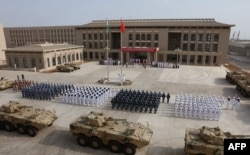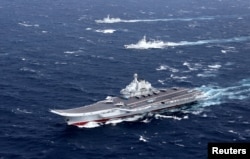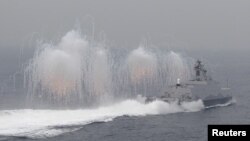Taiwan is facing a new source of pressure from rival China as the communist government increasingly often sends military aircraft to skirt the island, a challenge to the local armed forces.
Planes from China flew near Taiwan in November and December, raising concern last week at the presidential office in Taipei. Over the past two years, Chinese military units have sent planes 10 times just outside the Taiwanese air defense zone, former Taiwan defense minister Andrew Yang estimates.
China considers self-ruled Taiwan as part of its territory that must eventually be unified. Officials in Beijing resent Taiwan President Tsai Ing-wen for not accepting their “one-China” principle, which would bind the two sides under one flag, as a condition for any talks.
China is conducting the long-range flights in part to warn Taiwan against moving toward formal independence at the risk of a military strike, analysts say.
“They will try to test Taiwan’s government’s will to defend itself,” said Shane Lee, political scientist at Chang Jung Christian University in Taiwan. “They believe that continued threats will really bend Taiwan to its claim.”
The two sides have been separately ruled since Chiang Kai-shek’s Nationalists fled to Taiwan after the Chinese civil war, but the government in Taipei has never declared official independence. Surveys in Taipei show most Taiwanese oppose unification.
Show of strength
China runs the world’s third most powerful military after the United States and Russia. Taiwan’s armed forces rank 18th, according to the database GlobalFirePower.com.
The flights send a message to multiple countries, scholars say. Some of China’s aircraft fly near outlying Japanese islets and on over the Pacific Ocean.
China wants to prove it can send ships and planes past the “first island chain,” said Joshua Pollack, editor of The Nonproliferation Review in Washington.
The U.S. Navy and its allies, all leery of Chinese expansion, have normally dominated the waters east of that chain, which runs from Russia to the Philippines. The chain includes Taiwan.
China said in its official news media it had “fulfilled its long-held dream of breaking through” the island chain after ships passed in 2013 between Japan and Russia.
Exercises near Taiwan
A year ago December and into January, China sent an aircraft carrier, its only one at the time, around Taiwan.
Six Chinese bombers flew through the Miyako Strait north of Taiwan in July. Bombers and other aircraft flew through the strait in November as well as through the Bashi Strait separating Taiwan from the Philippines. On December 11 the Taiwan defense ministry said Chinese fighter planes had made another round through the two straits.
“This year there are many drills and training missions taking place surrounding the Bashi Strait,” said Yang, also secretary-general of the Chinese Council of Advanced Policy Studies think tank.
“We have to watch very closely what kind of tactics or fighting capabilities they have possessed so as to come up with countermeasures,” he said.
China has also shown discontent with the 20-month-old Tsai government by scaling back tourist arrivals to Taiwan, according to travel agencies in Taipei. Analysts and government officials suspect Beijing as well of persuading two countries to switch diplomatic recognition from Taiwan to China over the same period.
Measured response
Taiwan, which sits 160 kilometers from China at its nearest point, has sent its own aircraft to monitor China’s movements and urged people on the island to stay calm.
Yang said the Ministry of National Defense in Taipei is probably now considering how to ensure Chinese aircraft avoid flying into its air defense identification zone. Neither side wants a mishap, he added, while both sides know how to avoid one.
Taiwan is also developing its own naval ships and a trainer jet to keep its military up to date. Its chief foreign arms supplier, the United States, approves only occasional sales, such as a $1.42 billion package announced in June, to avoid angering Beijing too often.
On December 21, Tsai called China’s flights around Taiwan a conflict with regional stability. She ordered an air force command center to step up vigilance.
Taiwan’s armed forces will “just keep silent and then send their airplanes in the sky and send their ships watching,” predicted Liu Yi-jiun, public affairs professor at Fo Guang University in Taiwan. “Then probably we can make the point clear.














